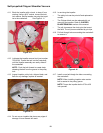
Self-propelled Chipper Shredder Vacuum
4
2.4. Watch the travel of the variable speed sheave
(pulley) on the input shaft. It may be necessary
to remove the belt to confirm that the variable
speed sheave has full travel. See Figure 2.4.
NOTE: Belt removed for clarity in figure 2.4
2.5. Confirm that the belt is routed properly.
2.6. Watch the reaction of the two idler pulleys. If the
bracket that they are mounted to does not pivot
freely in response to the changes in belt tension
created by the movement of the variable speed
sheaves, the full range of speeds will not be
available, and accelerated component wear will
result. See Figure 2.6.
2.7. If the idler pulleys do not react properly, confirm
that the spring is properly attached to tension
bracket and spring anchor bolt. See Figure 2.7.
2.8. If the belt and pulley system works properly,
turning the variable speed sheave on the trans-
mission input shaft, but fails to drive the wheels
when the self propel bail is lifted, then there may
be a problem in one of three areas:
• The cable that connects the bail to the clutch
mechanism.
• The final drive gears within the wheels.
• There may be an internal problem with the dog
clutch in the transmission. If there is an internal
transmission problem, replace the transmission.
2.9. To check the final drive gears, remove both rear
hubcaps. Remove the rear wheels using a 9/16”
wrench and a 1/2” wrench.
2.10. Check the condition of the teeth on the back of
the wheel.
Figure 2.4
Low speed position: High speed position:
Sheaves together Sheaves apart
Figure 2.6
Safety switch
Belt tensioner
Spring
Figure 2.7
Spring anchor bolt
Spring

















